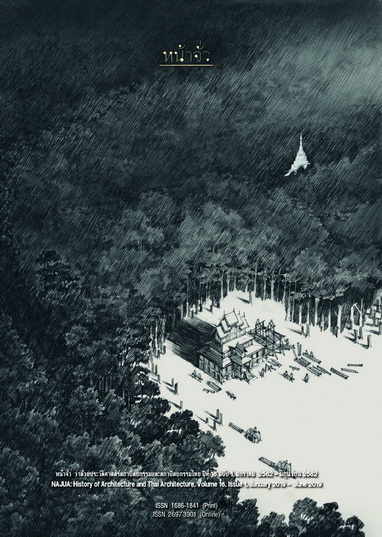Siri-Phat Rice Mill: Golden Age of Agriculture Industry in Phayao
Main Article Content
Abstract
The Siriphat Rice Mill is located in Phayao City, in the community called Nong-Rhabu. Historically, the Nong-Rhabu was a traditional community, used to be a centre of wholesale trade of agricultural products since 1916. However, due to the changing social and economic conditions and the creations of a new road and the city market which had become the trade centre instead, the community declines, while the Siripat Rice Mill deteriorates. Surveyed in 2016, the Siripat Rice Mill is no longer in use as a rice mill. Some are transforming many parts of their original functions, while others are dismantled. However, its structure and architectural style remain. Apart from its architectural values and the wide-span wooden structure which demonstrate traces of uses in the past, the Siripat Rice Mill also reflects the prosperity of this community.
This research aimed to explore the Siripat Rice Mill's history, to survey the mill's location and layout of the building, and to study the remaining structure in order to analyse its architectural significance in terms of functions and structure. Moreover, the study surveyed the opinions of peoples in Nong-Rhabu community and the area in front of the mill about their memories and the history of the mill. The result found is that the Siriphat Rice Mill is one of the buildings that people always mentioned when recollecting the community's prosperous past and that it always involved with the occupation and lifestyle of peoples in the community.
Downloads
Article Details
References
bān bōrān kwānphayao [Antique Houses at Kwanphayao]. Accessed December 6, 2019. Available from https://www.facebook.com/baanborankwanphayao/
Kriangsak Chaiyadarun, comp. yān kao mư̄ang kao nai Phayao [Old District Old Town in Phayao]. Phayao: Cultural
Exhibition Hall, Si Khom Kham Temple, 2015.
Kriangsak Chaiyadarun, comp. rākngao khō̜ng rao prawattisāt thō̜ngthin mư̄ang Phayao [Our Root: Local History of Phayao]. Phayao: Cultural Exhibition Hall, Si Khom Kham Temple, 2017.
Nidti Eoseewong. “Phayao kān plīanplǣng thāng sētthakit læ sangkhom [Phayao Economic and Social Change].” In prawattisāt sangkhom læ wattha natham mư̄ang Phayao [In Phayao: a Social and Cultural History], 498-512. Edited by Sujit Wongted. Bangkok: Matichon, 1995.
Phayao sak kam bō̜ [Phayao, Give it a Try One Time]. Accessed December 6, 2014. Available from https://www.
facebook.com/Phayao sakkambor177805405728281/
Plaiauw Chananon. “botbāt nāithun phō̜khā thī mī tō̜ kānkō̜ læ khayāi khō̜ng thunniyom phāk nư̄a khō̜ng prathēt
Thai Phō̜.Sō̜. 2464-2523 [The Role of Merchant Capitalists in Rise and Expansion of Capitalism in Northern Thailand, 1980 -1921].” Master’s Thesis, Chulalongkorn University, 1986.
Sujit Wongted. “prawattisāt læ phatthanākān thāng sangkhom læ watthanatham mư̄ang Phayao [History and Social and Cultural Development].” In prawattisāt sangkhom læ watthanatham mư̄ang Phayao [In Phayao: A Social and Cultural History], 5-53. Edited by Sujit Wongted. Bangkok: Matichon, 1995.
Sunthorn Suksaranchit. “nưngrō̜i pī khon Čhīn nai Phayao: phonwat thāngkān mư̄ang læ sangkhom [100 Years of Chinese People in Phayao: Political and Social Dynamics].” Journal of Social Sciences 11, ) 2 (July-December 2015): 99-135.
Suthee Mekboonsonglap. “kānsāng kān tranak rū nai dān prawattisāt phư̄nthī yān nō̜ng rabū tambon wīang ʻamphoē mư̄ang čhangwat Phayao [Building up Historical Awareness for Communities in NhongRabu,Tambon Wieng, Amphur Muang, Phayao].” JE-D: Journal of Environmental Design 3, 2 (July-December 2016): 51-71.
Witsanu Homnan, “rabop khrōngsāng langkhā phāt chūang kwāng khō̜ng rōngsīkhāo nai thǣp lum mǣnam Nān [Wide Span Roof Structure of Rice Mill in Nan River Basin].” Najua: Architecture, Design and Built Environment, no. 32 (January 2018): 41.


